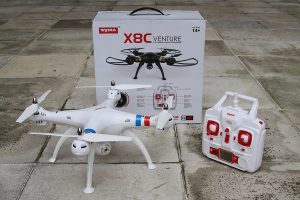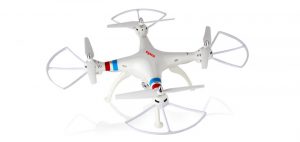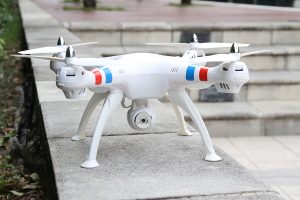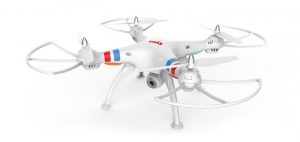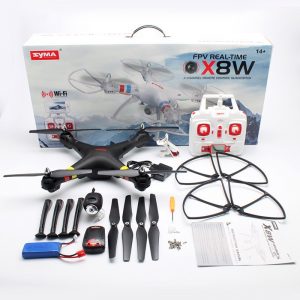The Syma X5SW is the latest and most advanced model in Syma’s X5 range of toy-grade quadcopters. It is also the priciest in the range, although only by a small margin, and is the only model to feature FPV (First Person View) video over wifi. Priced at approximately $61, it is available in black, red or white.
The X5SW is nearly identical to its other siblings — the X5SC and X5S. The only thing that sets it apart from the other two models is the FPV-enabled camera that sports a wifi antenna which is used to broadcast FPV video. This camera is essentially the same one used in the X5SC, with an added antenna that sticks out of its rear.
In fact, the X5SW is actually a X5SC with a pimped-up camera. It is even shipped with the same transmitter, accessories and battery as the X5SC. For this reason, I feel it is unnecessary to repeat the findings of my earlier review of the X5SC-1 here.
Some might be wondering, what is the difference between the X5SC-1 and the X5SC or the X5C-1 and the X5C? The truth is there is no difference between X5SC-1 and the X5SC. The “1” in the X5SC-1 model name is merely an indication that it is the “e-commerce” version of the X5SC. This means the X5SC-1 is shipped in a smaller box to reduce shipping costs while the X5SC comes in a larger box with a plastic handle at the top and is meant for retail shops. After all, a larger packaging means a more impressive presence for any product on a retail shelf which helps a lot in sales.
Specifications
- Dimensions: 310 x 310 x 105mm (with prop guards)
- Diagonal motor distance: 230mm
- Motor size: 8 x 20mm coreless
- Weight: 120g (with battery, camera and prop guards)
Flight time: - 6 to 8 minutes (without prop guards and camera)
- approximately 4 minutes (with prop guards and camera turned on)
- Battery: 3.7V 500mAh LiPo
- Charging time: 40-45 minutes
- Control distance: approximately 50m
- Transmitter power: 4 x 1.5V AA batteries (not included)
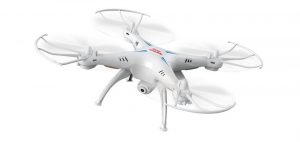
FPV on a Shoestring Budget
As mentioned earlier, the Syma X5SW can broadcast FPV video over wifi. To view the FPV video, you need to first install the Syma FPV app on your smartphone. The Syma FPV app is available for both Android and Apple IOS. Users of older Android devices will be in for a nasty surprise as Syma FPV is not compatible with Android 4.0 or earlier. For this review, an Android 4.2 smartphone was used and the app worked fine on it.
Once you have installed Syma FPV on your phone, run the app and turn on the X5SW. The camera takes about 30 seconds to set up its own wifi hotspot and once it’s running, connect your phone to the hotspot to view the FPV feed from the camera via the Syma FPV app.
The X5SW comes with a phone holder that can be attached to the top of the transmitter. This makes it easier for the pilot to view the FPV feed while operating the X5SW.
Since the X5SW transmits its FPV feed over wifi, the feed suffers from a lot of lag or latency. This means video from the quad’s camera can take up to about 2 seconds before it appears on your phone screen. Such high latency means the X5SW cannot be flown entirely using FPV and should be kept within line of sight at all times. Trying to fly the X5SW by relying on FPV may result in crashes, especially when it’s flown close to buildings or trees. With a latency of anywhere between 0.3 to 2 seconds, trying to avoid hitting a tree or wall is simply not possible.
Latency is hardly noticeable when the X5SW is flown within meters of your smartphone but as it gets further and further away, the latency gets worse. At about 50 meters, the latency becomes so bad that the video feed ends up looking like a slideshow of images being transmitted from the camera.
The X5SW is not a quadcopter meant for fast FPV racing. However, the FPV feature can be useful when you need to do things like align and frame a shot. The live FPV feed also means you don’t need to land the quad first before you can view what you have recorded. This makes the X5SW a highly affordable “flying camera” that allows people, for instance, to do live surveys of their properties from the air or to help in searching for missing livestock.
Unlike the X5SC and the X5C, the X5SW does not record videos or photos onto a micro SD card on its camera. Instead, recording is done on the smartphone via the Syma FPV app. This is a weak point in the X5SW’s FPV feature, particularly when you consider that the video transmission can suffer from really bad latency.
Flight Time
With its camera attached, the X5SW suffers from a very short flight time, especially when using the supplied 500mAh battery. With the supplied battery, flight time with FPV is approximately 4 minutes only. Using larger 750mAh batteries can increase flight times to 5 or 6 minutes which is still somewhat short. This is mainly because the camera draws a lot of power when transmitting its FPV feed. However, with the camera removed, the X5SW enjoys similar flight times as the X5SC and X5C.
Conclusion
The Syma X5SW throws many extremes into one package. On one hand, it costs only $61 and is the only model in Syma’s X5 range that features FPV. It is also one of the cheapest toy-grade quadcopters in the market that features FPV. On the other hand, its FPV feature is poorly implemented and suffers from a few drawbacks. The X5SW also suffers from the infamous “wind bug” issue that was covered in my earlier review of the X5SC-1. However, when one considers that drones with proper FPV features cost 10 to 20 times more than the X5SW, one can easily ignore its shortcomings.
As mentioned earlier, the X5SW is essentially a X5SC with a FPV camera and a new model name. This means it has all the good features seen in the X5SC such as a well designed and spacious battery compartment, tall landing legs and enclosed motors and pinion gears. If you can live without FPV, then you might want to consider the X5SC which costs a few dollars less and has better flight times. However, if you absolutely must have FPV, then the X5SW is one of the most affordable quadcopters out there that offers this feature, albeit with a few flaws that I believe many beginners can live with.
